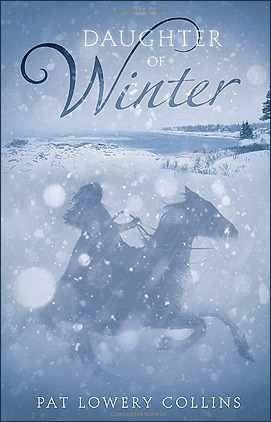Jeannine Atkins's Blog, page 32
September 9, 2011
The Hound Dog's Haiku and Other Poems for Dog Lovers by Michael J. Rosen illustrated by Mary Azarian

Michael J. Rosen offers twenty kinds of dogs each in a three-line poem that nudges us to see canines in new ways. And Mary Azazrian makes each woodcut come alive, combining bold lines with a sense of movement, whether the dogs are brooding, dozing (you know that lying on a back dreaming pose), showing off, waiting to greet the family with a welcoming bound, jumping for a Frisbee, digging among daffodils, sniffing or scratching. Each one is a unique portrait, and who can get tired of looking at Mary Azarian’s work? (I remember cheering with the librarian at my daughter’s elementary school when she won the Caldecott Medal for Snowflake Bentley.)
Here’s the haiku for Beagle:far off, one dog barks
dreams blur like smoke from chimneys
he barks at barking
I like the light touch and unexpected within each short poem of The Hound Dog’s Haiku (Candlewick). The notes at the end, of just a few elegant sentences each, add to our knowledge in a friendly way, with the author drawing on his personal experience as much as offering unusual facts. With a starred review from Kirkus, calling it “the Tao of dogginess,” this is s a great book for dog lovers or poetry lovers, and those of us who are crazy about both.
For the Poetry Friday roundup, please visit Secrets and Sharing Soda.
August 26, 2011
Paintings in Old Deerfield
Having kids leave home is hard. I still miss Emily, and I miss her friends and many of their parents, too. Jo-Ann Denehy, the mother of Nell, one of Emily’s best friends since kindergarten, doesn’t live far away, but mostly we keep up by the occasional email, which is not quite the same as stopping by to pick up Em and chatting while the girls bounced on a trampoline. Still it’s good, as is seeing Jo-Ann’s wonderful paintings on display here and there. The number, range, and beauty of her paintings has grown impressively these past years. Jo-Ann is a member of the Old Deerfield Painting Group, who just held their 22nd Annual Show at the White Church in Old Deerfield.
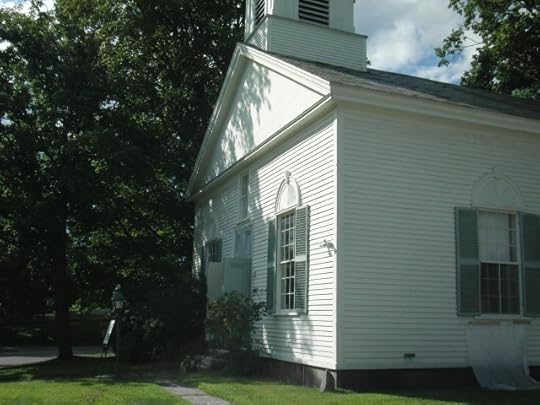
Here is “Cosmos and Hollyhocks,” though my photo doesn’t capture the rich colors.
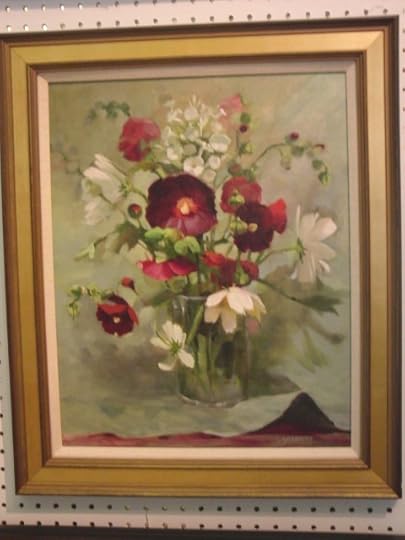
And here is “Still Life with Frog.” LJ is giving me a hard time posting pictures these days, but if you click on it, you can see the whole picture!
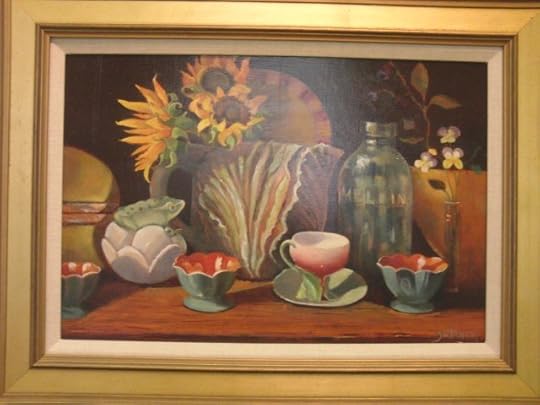
August 24, 2011
Gloucester and Rockport, Massachusetts
Peter and I have vacationed on the Maine coast with our daughter for years, but now that Emily lives on the west coast, we decided to explore other areas on short trips. Pat Lowery Collin’s show, which I blogged about on Monday, brought us to new and gorgeous beaches, some featuring rounded boulders rather than the broken cliffs we love in Maine. We heard the deep bass sounds, like thunder, at Bass Rocks, and trekked around Gloucester, stopping in at Cape Pond Ice, cutting and selling ice chiefly for storing fish for 160 years. We walked along the nearby Stacy Boulevard with the famous fisherman statue.
In the Cape Ann Museum, we saw another small statue of a woman holding a baby that Leonard Craske, who sculpted “Man at the Wheel” in 1925, thought should go with it, captained with lines from John Milton: Those also serve who only stand and wait. Funding and interest in a statue honoring women and children wasn’t there at the time, so this model was put away, and now sometimes displayed in the museum. Ten years ago, another beautiful statue, the Fisherman’s Wives Memorial by Morgan Faulds Pike was finally erected.
The Cape Ann Museum mixes art and history, and besides carved haddock bones, swordfish swords decorated with scrimshaw, examples of period furniture, models of sailboats, and paintings by Winslow Homer, who spent five summers in the area, Maurice Prendergast, Marsden Avery, and many others, we learned about a net-making company and the granite industry, which was interesting as we’d earlier walked at Halibut Point around an old granite quarry. My sister tells me we went there as children or young teens, but I couldn’t stir up a shred of memory. Maybe I stayed in the car reading, and my sister told me she probably commemorated the late afternoon in her diary with something along the line of: Went to Halibut Point. Boring, boring, boring. But we change, and now I found the water-filled quarry enchanting.
The Cape Ann Museum also holds work from the Folly Cover Designers, a group of 45 mostly women who focused on creating linoleum prints on fabric. We saw examples of cloth, a press, and a picture of one woman jumping on the block to press down the print. The group ran from 1938 to 1969, folding a year after the death of its founder, Virginia Lee Burton (1909-1968), author and illustrator of books including The Little House and Mike Mulligan and His Steam Shovel. Here’s a display of her sketchbook with cloth she designed.
I loved the history of Cape Ann, but also the clear light, blue water, round rocks, and seeing my husband enjoy those, too.
August 22, 2011
Books and Boulders: Works by Pat Lowery Collins
Peter and I just spent two days in Gloucester, MA area to enjoy the ocean in its late summer glory and to visit my talented friend Pat Lowery Collins –novelist, picture book writer, poet, painter, vocalist, and teacher. She has a show called “Books and Boulders” ending this week at the Gloucester Lyceum and Sawyer Free Library.
Pat’s work, mostly rocks and sea done in pastels, greets you when you enter the lovely library. She takes pictures of rocks near her home, then works from memory and imagination.
There’s an impressive display of work she’s written and sometimes illustrated.

Including her most recent historical novel for young adults, Daughter of Winter, set in nearby Essex in the mid 1800s.
I’ll write more about some other treasures of the area in the next day or two, but wanted to put up this post while people might have a chance to get to the show. I’m sorry I only got there in its last week, but so glad I did.
August 19, 2011
A Visit to The Robert Frost Farm
Peter and I recently spent two days near the New Hampshire coast, then drove back home by way of Derry, to see The Robert Frost Farm. Like the Frost Place in Franconia and the Stone House near Bennington, Vermont, which we visited earlier this year, this farmhouse was full of inspiration. Robert and Elinor Frost raised four children here from 1900 to 1911, on a farm his grandfather promised could be his if he stayed ten years. About forty poems were written at or inspired by the site, where he struggled for publication and tended chickens and peach and apple trees.
Our knowledgeable and enthusiastic guide brought us past the double privy, then the laundry room, and into the kitchen, where details had been overlooked by the oldest daughter, Lesley Frost Ballantine. There was a Glenwood stove and Royal Doulton china, which many neighbors considered an affectaion – steel plates should be good enough. The old tree that reflected many moods as Frost looked from the kitchen table is gone, but a new one has been planted.
Upstairs, we stood by a crib holding a small white nightgown that surely hadn’t been worn in a long, long time. Looking out toward the stairway, our guide spoke of Frost’s moving “Home Burial,” and the argument a bereaved couple have on the stairs. Neither Robert nor Elinor Frost may have ever fully recovered from the loss of a young son. There were two beds and two rooms for four children, and their daughter Lesley reported they shared by who was getting along with whom that day. Apparently Robert Frost’s parents celebrated their Scottish ancestry and literature by reciting ballads or reading at his bedtime, a tradition he continued with his children. His work of choice was Macbeth.

We stepped into the garret with slanting ceilings and saw the mattress on the floor. Here our guide spoke of “The Death of the Hired Man,” another poem that’s mostly dialogue, and which includes the line: “Home is the place where, when you have to go there,/They have to take you in.”
Frost said a scythe and a pen were his favorite tools. Peter and I walked on a path through the woods and around the old hayfield. Here’s our rainy-day view toward the house, which looks much prettier than it did in the 1950s when the owners filled it with broken-down cars, calling it Frosty Acres Automobile Graveyard. I was so shocked by the photos I didn’t get the Frost reference until Peter pointed it out. I suppose some of those neighbors were still talking about his high-faulting dinnerware. His daughter asked the state of New Hampshire for help buying it back and restoring it, which they did. She did her part staying in a trailer and overseeing details such as locating wallpaper and making sure that the washboard in the laundry room was made of glass and not steel, just like the one her mother used.
Please visit Dori http://dorireads.blogspot.com/ for the Poetry Friday roundup!
August 5, 2011
More on Louisa May Alcott: The Woman Behind Little Women

Some time ago, I heard Harriet Reisen read from her biography of Louisa May Alcott: The Woman Behind Little Women, which I posted about here. l I bought her book that night, but much as I enjoyed the talk, didn’t open it right away. I’ve read other biographies and thought I knew most of the story.
At last I picked up the book, which I highly recommend. Harriet Reisen’s love for Louisa May Alclott comes through, though after the warm introduction, she sticks to nineteenth century facts. There’s no authorial intrusion commenting on Louisa’s father, but her annoyance, which I’m well familiar with, at how Bronson Alcott often left much of not only raising the four girls but providing food for them to his wife subtly comes through. For instance, when describing how Bronson spent time in the Boston Athenaeum researching his ancestors, while his wife, Abby, tended to “the ancestors’ descendents.”
I knew the story of how James Field, well known editor of the Atlantic Monthly as well as books, including Nathaniel Hawthorne’s, turned down a story Louisa submitted with advice to “stick to teaching.” Ouch. And I thought those “sorry, not for us” notes hurt. Perhaps what bothered Louisa most was that Mr. Fields went so far as to include an offer of a loan to start a kindergarten, an offer Louisa felt compelled to take due to the family’s poverty. What was new to me, was that Louisa repaid this loan years later, when Little Women was a phenomenal best-seller. Again, Harriet Resien doesn’t write emotions a biographer might not know, but makes clear with what joy, and a certain warranted vengeance, Louisa must have penned the note she sent with a check for forty dollars.
And of course I knew that Louisa Alcott had died in 1888, two days after her father. But the ending of this biography is a lesson in how moving great nonfiction can be. There are no scenes such as Louisa wrote in her novels, but Resien sets the stage of Louisa failing from what was likely a stroke, lying with her older and only remaining sister by her bed. Anna was asked to tend to their father’s funeral, and Resien makes us feel how Anna must have hated to leave her dying sister. Duty called. Anna left. And I cried. Louisa May Alcott, who shaped so many people’s ideas of what family love might be, died with no one at her side.
August 3, 2011
Plot School on the Porch
1. Write a novel based in history, drafting it into what I think is perfection.
2. Hear, more than once, that the characters and situations are interesting, but it reads too much like biography, not enough like fiction.
3. Put away the manuscript and take about nine years to let this sink in. If you’re playing along at home, note that the waiting doesn’t have to be this extended. Just long enough to forget old habits, or ties to scenes that took some sweat. I waited while tending to other subject, but found this kept up a whisper in the closet, while other manuscripts stayed idle and quiet and done.
I started a rough draft of what I think are key scenes without rereading the original draft. I know. It’s like the wrapped present before your very eyes that you wait to open. I’m not always so good on the deferred gratification, but it helps that I know there will be dialog and details I can eventually plunder. And I like writing messy drafts on warm days.
4. Here in Plot School, I’m asking myself over and over, how does this scene change my protagonist? Then, when I don’t have good answers, leaving some history to history. Remembering most kinds of love are known by setbacks. Once or twice a day, I tidy these rambling pages. If I could fit them onto index cards I would, but I think of them as chunks that way. Reminding myself that each scene has to have walls or corners, places where people can badly stub their toes. I remember bits of scenes, carefully researched and phrased, that went into the original, but unless I see my character running into them and coming out changed, I’m telling myself to forgo. And be happy with more streamlined action. Some secondary characters will stay in the old box while I make my dear one hit walls. They may be almost invisible for another more plot-driven writer, but feel like high ones for me.
5. How’s it going? I really don’t know. I’ve had talks to myself about plot before and swore I was listening. But it’s hard to get past old habits. I have a high tolerance for lingering and meandering, in fact, it’s a pace I may love most. It serves me well in research, but there are times when busy readers would like us to move from A to not just B or C, but Q.
August 1, 2011
Pissarro's People
The Sterling and Francine Clark Art Museum is an especially nice place to visit in summer, when day lilies, daisies, chicory, and Queen Anne’s lace border so many roads to Williamstown, MA. And while this show focuses on people rather than landscapes, Camille Pissarro (1830-1903) often shows them working in fields and gardens, or in quiet moments by windows or haystacks. Seeing this work felt like a short vacation on the French countryside.
I learned that Pissarro was born in the Caribbean before coming to France to settle. He was a non-practicing Jew who married a Catholic woman who’d worked in his mother’s house. He painted many pictures of their eight children reading and drawing within a creative household, including a poignant series of a daughter, Minette, who died young. Beauty and tragedy, there on one wall.
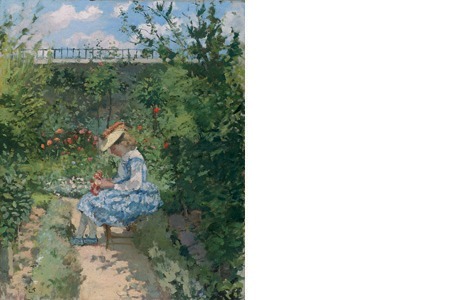
Another gallery focuses on domestic work, which is pictured with respect or romanticism, depending on your point of view: maybe a blend. He viewed the work of servants and farmers as being of great importance, but, while he expressed revolutionary points of view, you have to wonder whether the people he painted while sewing or harvesting were as happy as he hoped. His anarchist beliefs and faith in good country life paralleled those espoused by Tolstoy around that time. We get to view an album of drawings Pissarro made for his nieces that show his views of the ills of modern capitalism. While Pissarro made beautiful oil paints, he also took care to make drawings and prints that could be a more affordable way for people to put art in their homes.
The show will be up until October 2. And if you want to include a swim nearby-ish, I recommend Savoy State Park. Water: clear and cool.
Pisssarro's People
The Sterling and Francine Clark Art Museum is an especially nice place to visit in summer, when day lilies, daisies, chicory, and Queen Anne’s lace border so many roads to Williamstown, MA. And while this show focuses on people rather than landscapes, Camille Pissarro (1830-1903) often shows them working in fields and gardens, or in quiet moments by windows or haystacks. Seeing this work felt like a short vacation on the French countryside.
I learned that Pissarro was born in the Caribbean before coming to France to settle. He was a non-practicing Jew who married a Catholic woman who’d worked in his mother’s house. He painted many pictures of their eight children reading and drawing within a creative household, including a poignant series of a daughter, Minette, who died young. Beauty and tragedy, there on one wall.

Another gallery focuses on domestic work, which is pictured with respect or romanticism, depending on your point of view: maybe a blend. He viewed the work of servants and farmers as being of great importance, but, while he expressed revolutionary points of view, you have to wonder whether the people he painted while sewing or harvesting were as happy as he hoped. His anarchist beliefs and faith in good country life paralleled those espoused by Tolstoy around that time. We get to view an album of drawings Pissarro made for his nieces that show his views of the ills of modern capitalism. While Pissarro made beautiful oil paints, he also took care to make drawings and prints that could be a more affordable way for people to put art in their homes.
The show will be up until October 2. And if you want to include a swim nearby-ish, I recommend Savoy State Park. Water: clear and cool.
July 29, 2011
An End and a Beginning
Then I got to hit send. Let the wild rumpus begin.
And waiting, of course. To steer clear of over-obsessing, I’m thinking of ways to celebrate. Perhaps a bit more swimming, or going to lakes farther afield. Enjoying some of the books stacked around. And plunging into the new, which isn’t entirely new but working with memories of old research to stir up a ne plot and voice. After staring down commas, I’m glad to be reckless with punctuation. After forcing things into lines, I’m happy to let sentences and phrases fall where they will. I love this messy part of creation, putting down words without regard for the housekeeping that will have to come later. And I like to stare away from the pages and ponder. Especially in this season of day lilies. Which I'd show you, if the funkier-than-usual-this-week LJ would let me. So imagine, please, a sea of orange and green.










